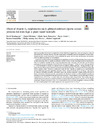Please use this identifier to cite or link to this item:
http://hdl.handle.net/10553/107468
| Title: | Effects of vitamin D3 supplementation in gilthead seabream (Sparus aurata) juveniles fed diets high in plant based feedstuffs | Authors: | Domínguez Montesdeoca, David Montero Vítores, Daniel Zamorano Serrano, María Jesús Castro Alonso, Pedro Luis Fontanillas, Ramón Prabhu, Philip Antony Jesu Izquierdo López, Marisol |
UNESCO Clasification: | 310502 Piscicultura | Keywords: | Vitamin D Gilthead seabream Requirements Optimum levels Skeletal anomalies, et al |
Issue Date: | 2021 | Project: | Consumer driven Production: Integrating Innovative Approaches for Competitive and Sustainable Performance across the Mediterranean Aquaculture Value Chain | Journal: | Aquaculture | Abstract: | Modern aquaculture feeds tend to contain lower levels of fish based ingredients, while increasing the content of plant ingredients. However, this may alter the vitamin profile of the feeds, leading to unbalanced vitamin supply. Requirements for several vitamins have been established for species such as carps and salmonids, but adequate levels for gilthead sea bream are yet unknown. Vitamin D is mainly involved in Ca homeostasis by regulating Ca uptake and liberation from bone intervening in bone remodeling. Fish are unable to synthesize vitamin D and so require absorbing it directly from the diet, thus, it is considered essential for fish. A practical plant-based diet containing 10% fish meal and 6% fish oil containing five levels of vitamin D3 (0.15, 0.43, 0.50, 0.55 and 0.65 mg kg− 1 or 5.8, 17.0, 20.0, 22.0 and 26.0 IU g− 1 ) were formulated to identify the optimum levels for gilthead seabream juveniles. Feeding juveniles of gilthead seabream with a range of vitamin D3 levels between 5.8 and 26.0 IU g− 1 for 70 days did not markedly alter growth. Increase dietary vitamin D3 significantly raised the liver contents in vitamin D3 in a dose-dependent manner following a potential regression. Increased dietary vitamin D3 levels up to 11.6 IU g− 1 may reduce the incidence of skeletal anomalies, particularly caudal and maxillary anomalies, whereas further elevation of dietary vitamin D3 levels increased the concentration of vitamin D3 in liver as well as skeletal anomalies in association to the up-regulation of alp and bmp2 gene expression. The occurrence of myocarditis signs in fish fed vitamin D3 levels of 20.0 IU g− 1 or more denote the toxic effects of these dietary levels. These results, together with the increased occurrence of skeletal anomalies in seabream fed the highest dietary vitamin D3 levels, suggest initial signs of hypervitaminosis D. Thus, the recommended level for vitamin D3 for gilthead seabream juveniles fed diets containing high levels of plant ingredients was suggested to be 11.6 IU g− 1. | URI: | http://hdl.handle.net/10553/107468 | ISSN: | 0044-8486 | DOI: | 10.1016/j.aquaculture.2021.736991 | Source: | Aquaculture [ISSN 0044-8486], v. 543, 736991, (Octubre 2021) |
| Appears in Collections: | Artículos |
SCOPUSTM
Citations
16
checked on Apr 14, 2024
WEB OF SCIENCETM
Citations
12
checked on Feb 25, 2024
Page view(s)
164
checked on Jan 20, 2024
Download(s)
125
checked on Jan 20, 2024
Google ScholarTM
Check
Altmetric
Share
Export metadata
Items in accedaCRIS are protected by copyright, with all rights reserved, unless otherwise indicated.
